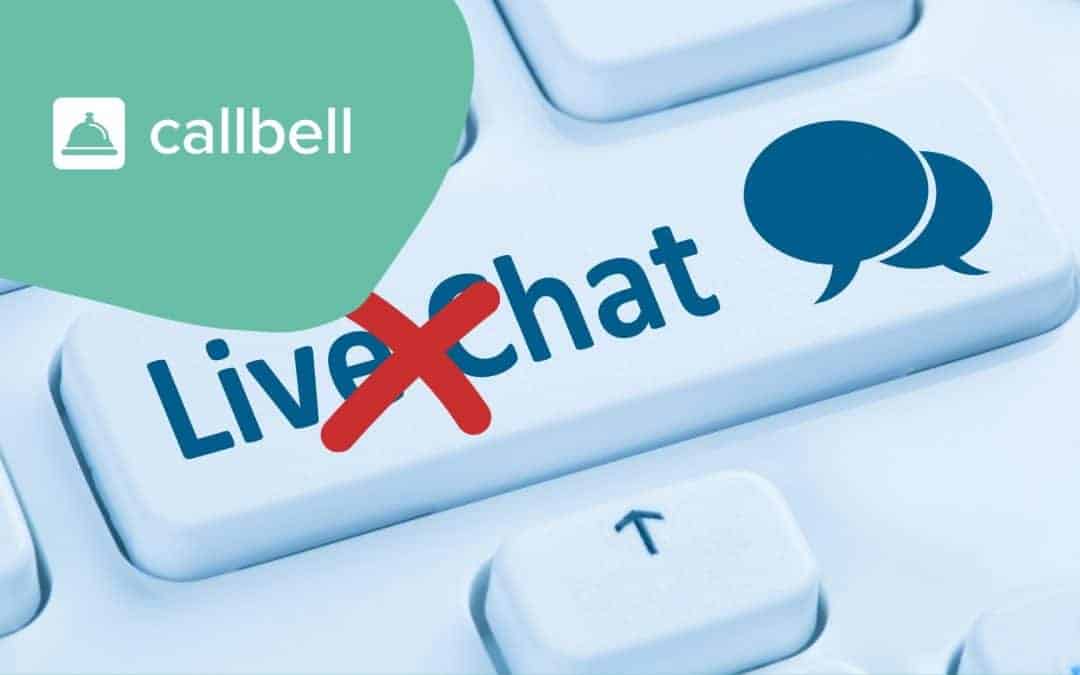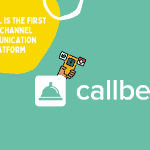Index
- Why should a company replace the Live chat system with instant messaging applications and what are the differences?
- What is a live chat?
- What are messaging apps?
- What are the main differences between live chats and messaging apps?
- Disadvantages of using a live chat
- Benefits of using a messaging app
- What are the best live chats?
- What are the best messaging apps?
- Why is Callbell the best alternative to traditional Live Chat tools?
- Outline of how live chat and messaging apps work
For a long time, live chats have been preferred by most companies to serve their customers. Live chat was a groundbreaking stage that improved and changed the way businesses communicated with their customers, until today. For those who don’t know, this type of tool is installed directly on the homepage of a website and its features vary depending on the tool or company that provides it. Or rather, some of these platforms may offer automatic replies and live chat. Others simply chat live or send emails and communicate using the chats themselves. Depending on the tool, some features may change; however, the main idea of live chats is to offer a tool that allows you to serve customers in real time through a chat located on the main page of your website.
Now that we have a better understanding of what a live chat is and how it has helped us over the years, it’s time to talk about messaging apps. These tools are relatively new and come as a super powerful evolution of live chats. These platforms not only allow you to serve customers in real time, but also allow you to store conversations, archive contacts, and keep communication alive.
Using these types of tools has been shown to increase conversion rate and retention in conversations, response rate grows and users or customers feel more comfortable, and it improves how they are contacted by businesses. A great example of this type of platform is Callbell. This tool allows you to serve customers directly from your website via WhatsApp, Telegram, Facebook Messenger or Instagram Direct, offering a wide variety of contact methods that are most used by online users today.
When we talk about the differences between these two types of tools, we mean that they both have the same purpose: to serve customers efficiently. They both do this, but in very different ways: while live chats have few features like real-time chat, email, or bots, messaging apps bring together the communication channels most used by users, integrate them into their platform, and offer a communication solution in one place, metrics, configurations for sales team, customer service or call center, increasing the rates of response, sales or responsiveness of customers.
In this way, messaging apps offer a positive change in the way businesses communicate with their customers. They are the evolution of live chats with many additional and specialized features for today’s business models. They are the best solution for new markets and new ways people shop over the Internet in 2021. That’s why, in this post, we’ll tell you about the benefits of using a messaging app and what differences there are between a live chat and an app.
A live chat service or platform on a commercial website plays a decisive role in strengthening the connection between the website and its visitors. It allows you to quickly capture or channel interest in the website services or products through the homepage, making sure that your company’s agents can guarantee a chat that attracts the attention of all website users. When learning how to make a website, you’ll see the important role it plays for customer success.
When a visitor enters a website (directly or through a search engine), he is still oriented towards the reasons that led him to carry out that particular search. That is why their willingness to establish a first contact is quite high. Therefore, the user will look for the fastest form of communication within the website.
The live chat service or platform allows you to take full advantage of this situation, offering the visitor the opportunity to make a query in real time, thus starting a sales process. Beyond the final result, the attraction rate of visitors, converted from that moment into prospects, multiplies (optimizing the investments that could be made in positioning or in web marketing advertising campaigns). But as we explained in this article, the conversations of those who leave the website before they are done talking to an agent are lost in the process, unable to be recovered.
While live chats solve a momentary need, they’re not the most suitable tools to use in a sales process, as many conversational customers leave just an email as a contact tool. And email messages generally go unanswered. Hence, customers who leave live chats are lost, and this is a particularly negative and nefarious factor for this type of instrument.
Messaging apps are relatively new tools that have emerged as a communication solution for businesses. These apps have different configuration and integration models that facilitate the way businesses interact with their customers.
Some of these tools have a large number of integrations that make them powerful sales, management and customer service tools. They have the ability to be used as a CRM, offer metrics to analyze and measure the performance of sales or service teams. They connect with today’s major media such as WhatsApp, Telegram, Facebook or Instagram and increase the percentage of conversations open and lead conversions.
Messaging apps have changed the way businesses interact with their customers. Communication is no longer in one place, it is omnichannel and can be attended at any time and place. One of the great advantages of this new group of tools is that most of them have a version of the app that allows agents to manage chats from their mobile phones, being able to communicate through social networks and not from a single web page, which offers more trust between customers and the company.
All this requires a more humanized and personalized contact with customers. This translates into more and better sales, excellent results, and more organized teams.

There are many differences between live chats and messaging apps. In this list, you will find the most important ones:
Live chats:
1) Classification of chats by type of query.
2) Attention in real time.
3)Gathering of information (e-mail and name)
4) Agent statistics.
5) Performance analysis.
6) Start conversations with a single button.
7) Quality of customer service.
8) Integration with Facebook Messenger (some)
9) Surveys (some)
As you can see, live chats have multiple uses and functionalities. However, they are insufficient according to user requests or requirements. This is because different forms of communication have emerged and users prefer to talk via more direct messaging apps, such as WhatsApp, Telegram, Messenger or even Instagram Direct.
For this reason, live chat is no longer the first option when looking for a customer communication solution from companies.
Messaging apps
Messaging apps are the revolutionary new communication solution for businesses. These offer great benefits and features that facilitate the service, sales and support process for customers and leads. Their main differences from live chats are:
1) Integration of the main communication channels (apps) of today.
2) They offer specific metrics to monitor agent performance.
3) Specific metrics to improve business performance.
4) Multiple integrations with external tools.
5) Integrated CRMs .
6) Labels to define the phases of the sales process.
7) Ability to connect multiple agents to different service channels.
8) Omnichannel collaborative environment between users.
9) Conversations in real time.
10) Ability to save customer data such as WhatsApp, Telegram, phone number, email, etc.
11) Optimization for sales, support or call center teams.
As you can see, messaging apps are definitely destined to stay in the corporate environment, presenting a complete solution for all business needs. Therefore, through these tools you will be able to manage and improve your sales by giving support, without having the limits of agents capable of serving your multiple communication channels, improving the quality of service, the percentage of sales and customer satisfaction.
Live chat has multiple disadvantages in current business models. In this section, we will show you why live chat is no longer an indispensable tool and why you should stop using it.
Disadvantages of live chat
1) They have only one service channel (the web)
2) They do not have integrations adapted to new business models.
3) They only capture basic user data like email.
4) The conversation gets lost once the user leaves the web page.
5) It is not possible to resume conversations unless the user starts them again.
6) The prices for this type of tool are very expensive and not very functional in the new business models.
Messaging apps are a big plus when it comes to live chats. These integrate multiple communication channels (messaging apps) into a single multi-channel platform, allowing you to connect multiple agents and analyze the performance of each along with business growth. These messaging apps feature many specialized integrations in order to improve the sales process and customer service.
Benefits of using messaging apps
1) Connect messaging apps like WhatsApp or Telegram.
2) Multiple agents for each connected app.
3) Collaborative and optimized platform for sales management, support or call center.
4) Specialized metrics to measure performance by agent, team and company.
5) Create check tags for each stage of the conversation.
6) Integrated CRMs .
7) Multiple integrations with external tools.
8) Improve customer loyalty.
9) Improve the percentage of open messages.
10) Customer loyalty.

There are a lot more live chats today; however, there are 3 that can be called the best on the market, and these are:
1) LiveChat
It is one of the most stable live chats. It has multiple live chat options, with a simple chat form that clears all notifications. You will be able to manage multiple chats and receive a notification every time a customer wants to communicate with an agent.
You will have the ability to customize the look of the chat and manage multiple live conversations and tickets. In addition, the app has options for sending messages such as tags, voice notes or files.
2) LiveAgent
It is the perfect app for companies looking for service and technical support solutions. If you want to improve your customer service approach and make everything a little more interesting for your staff, this solution makes it easy and quick to track your support stats, evaluate data like hourly responses, and more.
You can also allow your agents to earn a variety of badges and rewards through an automation system for their work.
LiveAgent is an alternative to some of the standard solutions available on the market today for customer service and live chat; however, it does not differ from what are the normal live chats.
3) Olark
Olark is a chat tool that allows you to talk to all website visitors. The platform has a fairly clean and intuitive design, easy to use and allows you to manage more than one chat in real time. In this sense, Olark presents integrations and functions that allow you to build a solid relationship with customers.
It also has features like personalization, automatic messages, real-time reports, team management tools, and much more.
4) Tidio
Tidio is a live chat or communicator for companies that keeps live chats, Messenger and email in one place. Tidio owns 2 main products: live chat and chatbot. This means that it focuses on automating the different steps that go through a conversation with those who visit your website.
This tool is primarily a live chat that helps you serve your customers in real time, nothing more, nothing less. The price is quite affordable; however, if you want to add features such as multiple agents or chat permissions, you will have to pay a surplus.
5) Tawk.to
Tawk.to is a free messaging app that allows you to monitor and chat with website visitors, or mobile app users. It also allows you to create a support center where users help each other. Installing it is super easy, just copy a line of JavaScript into your website’s HTML and the chat widget will start working right away.
6) SmartSupp
SmartSupp is a live chat that offers recordings that allow you to observe all visitor movements on your website. It also offers, like all live chats, a button that allows you to start a conversation from the main window of your website. This way, you can serve customers in real time. The app integrates Facebook, Live chat and email.

Among the messaging apps that have the best performance in terms of quality, service and price, we have:
1) Callbell
Callbell is a tool developed mainly for companies that can offer sales or support to their customers through social networks (Instagram Direct, Telegram, Facebook Messenger or WhatsApp).
Its platform offers features developed specifically for the corporate environment. You will have a metrics section where you can track your activity. Plus, you will also have the possibility to activate automatic routing that assigns conversations, an internal chat between agents, derivation of conversations and all this in one place.
The service centralizes all the conversations of the different social networks into a single mailbox, where messages are assigned to the support agents available in your company.
2) Lead Sales
LeadSales focuses on the CRM for WhatsApp feature which makes it a CRM for the aforementioned platform. Generally, these types of companies can integrate more than one information channel. Despite this, for its part, Leadsales only integrates WhatsApp, having been designed to use only that platform.
On the other hand, it offers some very interesting features: an analytics and metrics panel to keep track of your business and your agents from month to month, an administrative panel and a particularly useful feature: the sales funnel. This will help you get more qualified leads willing to acquire your service. Compared to WhatsApp, however, it offers you an integrated system that allows you to have a single number and multiple agents to reply to messages.
3) Wati
Wati is a company 100% focused on offering a service developed and focused on customer service through WhatsApp. The service creates a unique solution for that platform. This allows you to focus its full potential on a tool that has all the necessary features such as multi-agent WhatsApp, CRM and WhatsApp API in such a way as to be able to cover most of the needs from the app.

Generally, companies should adopt and use messaging apps as a communication solution, thus ceasing to place such importance on live chats. This is because live chats are tools that limit communication. When we talk about limitations, we mean that these types of tools allow the company to communicate with customers who visit its website exclusively in real time. On many occasions, these conversations are left hanging and the company only receives emails from the people it communicates with.
As we all know, emails are not the best communication channel these days and the best idea would be to use social networks or messaging apps in order to get a faster response and a higher opening rate. Unfortunately, live chats do not have these kinds of integrations and are limited to just managing conversations with visitors to a particular website in real time and, as we said earlier, many conversations will be doomed to be lost.
It is precisely for this reason that we recommend the use of tools such as Callbell, capable of using messaging apps as the main mode of communication. Callbell is a tool specialized in omnichannel communication, as it brings together different types of social networks into a single collaborative platform. This allows you to connect your entire team in one place and respond to all messages from your communication channels effectively, efficiently and quickly.
With Callbell you will be able to manage chats, make sales, automatically reply up to two levels of conversation, manage your leads, metrics and internal chats between the same agents. If you want to try Callbell and all the advantages you need for perfect communication and an omnichannel strategy click here!

Frequent Questions
What are the disadvantages of using a Live chat?
Live chats have multiple disadvantages in today’s business models. Here we will show you why live chat is no longer an indispensable tool and why you should stop using it and prefer messaging apps instead.
Disadvantages of live chats
- They have only one service channel (the web).
- They do not have integrations adapted to new business models.
- They only capture basic user data like email.
- The conversation gets lost once the user leaves the web page.
- It is not possible to resume conversations unless the user starts them again.
- The prices for this type of tool are very expensive and not very functional in the new business models.
What are messaging apps?
Messaging apps are relatively new tools that have emerged as a communication solution for businesses. These apps have different configuration and integration models that facilitate the way businesses interact with their customers.
Some of these tools have a large number of integrations that make them powerful sales, management and customer service tools. They have the ability to be used as a CRM, offer metrics to analyze and measure the performance of sales or service teams. They connect with today’s major media such as WhatsApp, Telegram, Facebook or Instagram and increase the percentage of conversations open and lead conversions.
About the author: Hello! I am Alan and I am the marketing manager at Callbell, the first communication platform designed to help sales and support teams to collaborate and communicate with customers through direct messaging applications such as WhatsApp, Messenger, Telegram and Instagram Direct




